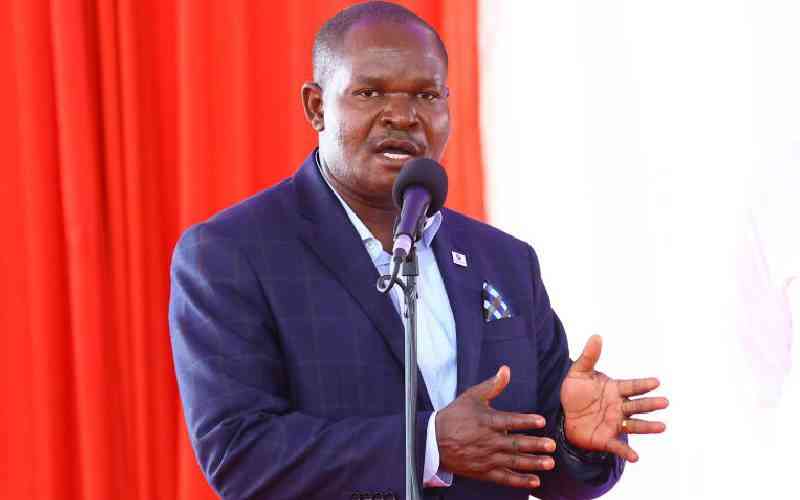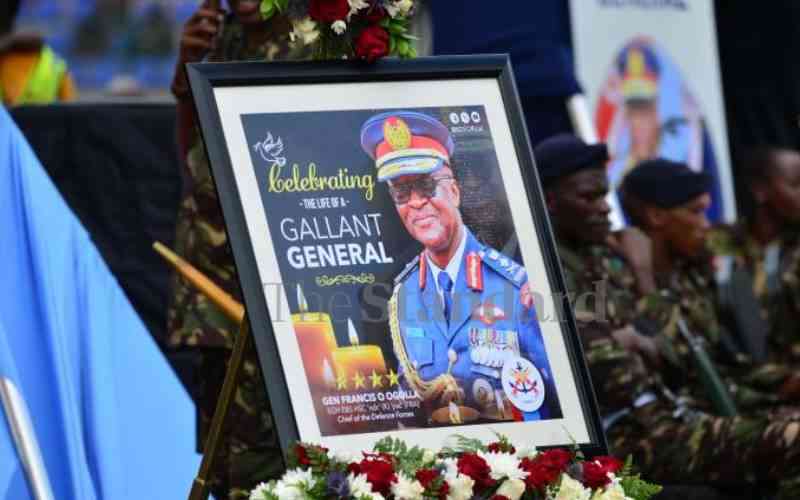By AMOS KAREITHI
A raging debate in the House of Lords in 1963, touching on the secession of what was then Kenya’s Northern Frontier District, had ramifications that are still being felt today
With only three months to Kenya’s self-governance, a malevolent wind that would haunt the nation for the next half century started sweeping across the country.
These ominous developments took a definitive turn on April 3, 1963. As the budget was being read in Nairobi, a debate that would chart the destiny of millions in Kenya, Ethiopia and Somalia was raging in the House of Lords in London.
The effects of this debate continue to reverberate half a century later, and could perhaps explain why, until the promulgation of the Constitution, Kenya was divided into eight provinces.
It also explains why Somalia’s flag has a five-point star. One of the points of the flag represents Somalis living in Northern Frontier District (NFD) in Kenya while the other four represent Somalis in British Somaliland, Djibouti, Ethiopia, and Italian Somaliland.
Incredibly, this international crisis was triggered by a barren region neglected by colonialists since 1895, despite constituting half of Kenya’s land mass and being three times the size of Britain.
Marginalisation
According to the Hansard, the debate exploded when the Earl of Lytton, Noel Anthony, sought to champion the secession of the NFD to Somalia. The timing of his debate was telling in that Kenya was just months away from being declared independent.
While introducing the debate, Lord Lytton appreciated the fact that in some countries, secession was punishable by shooting. Nevertheless, he traced the origin of the creation of a Greater Somalia to Sir Charles Eliot, Kenya’s first governor, in 1904 and Mohammed Abdilla Hassan, commonly known as “The Mad Mullah”, between 1899 and 1920.
“The idea has been backed by the emperor of Ethiopia on a number of occasions, always with the intention of incorporating the entire Horn of Africa within the Ethiopian Empire. Finally, there was Mr Ernest Bevin in 1946,’’ Lytton said.
He detailed the extent of the region’s marginalisation by his own government , saying the area was only referred to as a district, not even a province.
“The whole population is regarded as of such small account that it is not summarised in the main tribes in the Kenya Statistical Abstract of 1960.”
Lytton described the NFD as one of the poorest places that people have ever quarrelled about, adding that although there was the possibility of oil, this was not the reason for conflict.
Artificial frontiers
Stay informed. Subscribe to our newsletter
He said the idea of secession had been motivated by the fact that the Somali people who live in the NFD shared a common language and religion with their brothers in the Somali Republic and in Ogaden, Ethiopia. The bond they shared had defied decades of artificial frontiers imposed on them by the colonialists.
This, along with the fact that in their 70 centuries of recorded history, they had appeared to dominate other Africans, Lytton argued, had caused tension.
Apparently there was a greater plan to have a regional federation, which would cover Somalis in Uganda, Ethiopia and Kenya.
However these plans, which had tacit approval from Somalia, caused some disquiet in Kenya’s political landscape. Although at that time Kanu, led by Jomo Kenyatta, and Kadu, under Ronald Ngala, rarely agreed on anything, they were united in opposing the reduction of Kenya by half.
In a move aimed at cooling tempers, the Government held the Kenya Constitutional Conference of 1962, where residents of NFD were invited to give their views.
An estimated 40,000 people attended the barazas, where 134 delegates were interviewed and 106 gave written submissions.
The outcome was as contentious as the raging debate. Although one side claimed the residents were overwhelmingly for secession, with 86 per cent in support, the Government, on the other hand, said the move had been rejected.
When Lytton brought his motion before the House of Lords, it was equally divisive.
Reading parts of the report, he said,” We found that the people there almost unanimously favoured the secession from Kenya of the NFD when Kenya attains independence, with the object of ultimately joining the Somali Republic.”
Those who wanted secession, however, wanted to join Somalia as a self-governing unit.
However, critics opposed to Lytton’s motion warned that it would be wrong for Britain to cede any part of Kenya before the country got independence.
Severed ties
Lord Francis Listowel summed up the feeling of Kenyan leaders when he argued, “This is the most serious threat to peace in any part of Africa at the present time. If we abandon Kenya without a settlement, we shall be leaving a built-in cause of war between Kenya and Somalia.”
He further opined that Britain could not afford to expose Kenya to an armed conflict with one of its neighbours, especially when it would not have the protection of British troops.
Even as this debate was raging, Somalia had already severed ties with Britain, and violent demonstrations had rocked parts of Mogadishu.
Dr Abdirashid Ali Sharmake, Somalia’s Prime Minister at the time. In a letter dated March 17, 1963, which Lytton read to the House of Lords, Sharmake said: “Dear Lord Lytton, you will have heard by now that my government, has been forced into breaking off diplomatic relations with Britain following the unacceptable and uncompromising policy statement about the NFD on March 8.”
“Spontaneous demonstrations of protest broke out in Mogadishu as soon as his announcement was heard over the radio”.
Although the motion for secession was later withdrawn and the colonial government created a semi-autonomous region for the NFD, the seeds of discord had already been planted.
Grim consequences
The residents of the NFD were forbidden from participating in the General Election in 1963. There was violence which resulted in several deaths in Isiolo, after some residents tried to defy the election ban.
Even before Kenya gained independence in December 1963, the words of Francis Hastings, Earl of Huntingdon, who had warned of grim consequences if the concerns of the Somali were not addressed, came true.
“There will be dragons’ teeth that will rise up and produce warriors against the Kenya Government. It will put that government in an impossible position. They almost certainly will not be able to subdue this very proud, gallant people. If they did, it would lead to their slaughter on a gigantic scale,” Lord Huntingdon had said.
There were already signs of trouble because a few days before the debate, on April 1, The Times of London had reported an attack, which had resulted in the death of a police officer.
“That is probably only the beginning,” Huntingdon warned. “If we persist in what seems to them to be a betrayal of their rights and interests and the worst kind of provocation.
“We should also recognise that the Somalis are very fine people indeed. They are extremely good fighters and warriors, probably the best in Africa. They live in a wild desert country, which would be extremely difficult to subdue, and they are experts in guerrilla warfare.”
Predictably, between November and December, even before Kenya had tasted independence, militia attacked from Somalia. They targeted military posts and police stations at a time when Kenyans military might comprised of a paltry 2,700 men led by 200 British troops.
This marked the beginning of a protracted armed conflict that would lead to a declaration of a State of Emergency in the NFD (renamed North Eastern Province) as well as Tana River and Lamu. An estimated 3,000 people died.
The dragon’s teeth that the aristocrat warned about seem to have become a nightmare, haunting the successive regimes as insecurity takes its toll on the region.
The government appears to have been unable to eradicate the bands of outlaws who have been attacking government installations and public places with worrying frequency.
Fifty years later, sections of this region have never known peace and are still wallowing in poverty and marginalisation.
The writer can be reached on [email protected]
 The Standard Group Plc is a
multi-media organization with investments in media platforms spanning newspaper
print operations, television, radio broadcasting, digital and online services. The
Standard Group is recognized as a leading multi-media house in Kenya with a key
influence in matters of national and international interest.
The Standard Group Plc is a
multi-media organization with investments in media platforms spanning newspaper
print operations, television, radio broadcasting, digital and online services. The
Standard Group is recognized as a leading multi-media house in Kenya with a key
influence in matters of national and international interest.
 The Standard Group Plc is a
multi-media organization with investments in media platforms spanning newspaper
print operations, television, radio broadcasting, digital and online services. The
Standard Group is recognized as a leading multi-media house in Kenya with a key
influence in matters of national and international interest.
The Standard Group Plc is a
multi-media organization with investments in media platforms spanning newspaper
print operations, television, radio broadcasting, digital and online services. The
Standard Group is recognized as a leading multi-media house in Kenya with a key
influence in matters of national and international interest.








